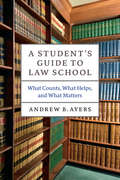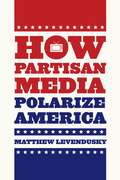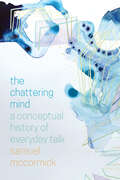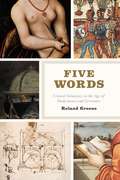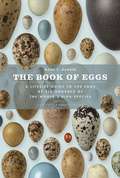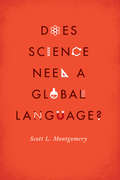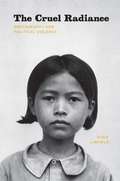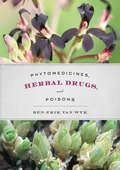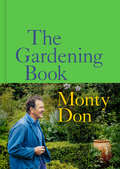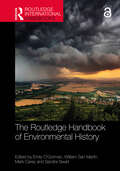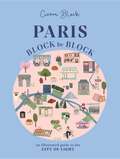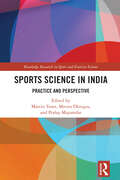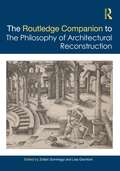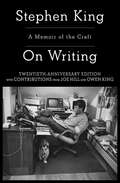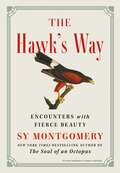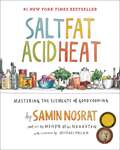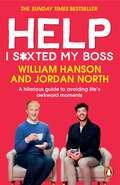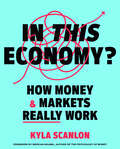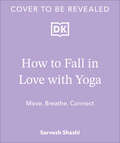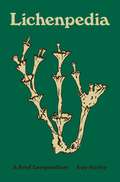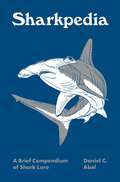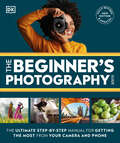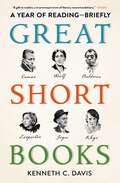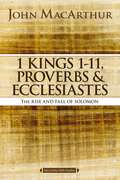- Table View
- List View
A Student's Guide to Law School: What Counts, What Helps, and What Matters (Chicago Guides To Academic Life Ser.)
by Andrew B. AyersLaw school can be a joyous, soul-transforming challenge that leads to a rewarding career. It can also be an exhausting, self-limiting trap. It all depends on making smart decisions. When every advantage counts, A Student’s Guide to Law School is like having a personal mentor available at every turn. As a recent graduate and an appellate lawyer, Andrew Ayers knows how high the stakes are—he’s been there, and not only did he survive the experience, he graduated first in his class. In A Student’s Guide to Law School he shares invaluable insight on what it takes to make a successful law school journey. Originating in notes Ayers jotted down while commuting to his first clerkship with then-Judge Sonia Sotomayor, and refined throughout his first years as a lawyer, A Student’s Guide to Law School offers a unique balance of insider’s knowledge and professional advice. Organized in four parts, the first part looks at tests and grades, explaining what’s expected and exploring the seven choices students must make on exam day. The second part discusses the skills needed to be a successful law student, giving the reader easy-to-use tools to analyze legal materials and construct clear arguments. The third part contains advice on how to use studying, class work, and note-taking to find your best path. Finally, Ayers closes with a look beyond the classroom, showing students how the choices they make in law school will affect their career—and even determine the kind of lawyer they become. The first law school guide written by a recent top-ranked graduate, A Student’s Guide to Law School is relentlessly practical and thoroughly relevant to the law school experience of today’s students. With the tools and advice Ayers shares here, students can make the most of their investment in law school, and turn their valuable learning experiences into a meaningful career.
How Partisan Media Polarize America (Chicago Studies In American Politics Ser.)
by Matthew LevenduskyForty years ago, viewers who wanted to watch the news could only choose from among the major broadcast networks, all of which presented the same news without any particular point of view. Today we have a much broader array of choices, including cable channels offering a partisan take. With partisan programs gaining in popularity, some argue that they are polarizing American politics, while others counter that only a tiny portion of the population watches such programs and that their viewers tend to already hold similar beliefs. In How Partisan Media Polarize America, Matthew Levendusky confirms—but also qualifies—both of these claims. Drawing on experiments and survey data, he shows that Americans who watch partisan programming do become more certain of their beliefs and less willing to weigh the merits of opposing views or to compromise. And while only a small segment of the American population watches partisan media programs, those who do tend to be more politically engaged, and their effects on national politics are therefore far-reaching. In a time when politics seem doomed to partisan discord, How Partisan Media Polarize America offers a much-needed clarification of the role partisan media might play.
The Chattering Mind: A Conceptual History of Everyday Talk
by Samuel McCormickFrom Plato’s contempt for “the madness of the multitude” to Kant’s lament for “the great unthinking mass,” the history of Western thought is riddled with disdain for ordinary collective life. But it was not until Kierkegaard developed the term chatter that this disdain began to focus on the ordinary communicative practices that sustain this form of human togetherness. The Chattering Mind explores the intellectual tradition inaugurated by Kierkegaard’s work, tracing the conceptual history of everyday talk from his formative account of chatter to Heidegger’s recuperative discussion of “idle talk” to Lacan’s culminating treatment of “empty speech”—and ultimately into our digital present, where small talk on various social media platforms now yields big data for tech-savvy entrepreneurs. In this sense, The Chattering Mind is less a history of ideas than a book in search of a usable past. It is a study of how the modern world became anxious about everyday talk, figured in terms of the intellectual elites who piqued this anxiety, and written with an eye toward recent dilemmas of digital communication and culture. By explaining how a quintessentially unproblematic form of human communication became a communication problem in itself, McCormick shows how its conceptual history is essential to our understanding of media and communication today.
Five Words: Critical Semantics in the Age of Shakespeare and Cervantes
by Roland GreeneBlood. Invention. Language. Resistance. World. Five ordinary words that do a great deal of conceptual work in everyday life and literature. In this original experiment in critical semantics, Roland Greene considers how these words changed over the course of the sixteenth century and what their changes indicate about broader forces in science, politics, and other disciplines. Rather than analyzing works, careers, or histories, Greene discusses a broad swath of Renaissance and transatlantic literature—including Shakespeare, Cervantes, Camões, and Milton—in terms of the development of these five words. Aiming to shift the conversation around Renaissance literature from current approaches to riskier enterprises, Greene also proposes new methods that take advantage of digital resources like full-text databases, but still depend on the interpreter to fashion ideas out of ordinary language. Five Words is an innovative and accessible book that points the field of literary studies in an exciting new direction.
The Book of Eggs: A Life-Size Guide to the Eggs of Six Hundred of the World's Bird Species
by Mark E. HauberFrom the brilliantly green and glossy eggs of the Elegant Crested Tinamou—said to be among the most beautiful in the world—to the small brown eggs of the house sparrow that makes its nest in a lamppost and the uniformly brown or white chickens’ eggs found by the dozen in any corner grocery, birds’ eggs have inspired countless biologists, ecologists, and ornithologists, as well as artists, from John James Audubon to the contemporary photographer Rosamond Purcell. For scientists, these vibrant vessels are the source of an array of interesting topics, from the factors responsible for egg coloration to the curious practice of “brood parasitism,” in which the eggs of cuckoos mimic those of other bird species in order to be cunningly concealed among the clutches of unsuspecting foster parents.The Book of Eggs introduces readers to eggs from six hundred species—some endangered or extinct—from around the world and housed mostly at Chicago’s Field Museum of Natural History. Organized by habitat and taxonomy, the entries include newly commissioned photographs that reproduce each egg in full color and at actual size, as well as distribution maps and drawings and descriptions of the birds and their nests where the eggs are kept warm. Birds’ eggs are some of the most colorful and variable natural products in the wild, and each entry is also accompanied by a brief description that includes evolutionary explanations for the wide variety of colors and patterns, from camouflage designed to protect against predation, to thermoregulatory adaptations, to adjustments for the circumstances of a particular habitat or season. Throughout the book are fascinating facts to pique the curiosity of binocular-toting birdwatchers and budding amateurs alike. Female mallards, for instance, invest more energy to produce larger eggs when faced with the genetic windfall of an attractive mate. Some seabirds, like the cliff-dwelling guillemot, have adapted to produce long, pointed eggs, whose uneven weight distribution prevents them from rolling off rocky ledges into the sea. A visually stunning and scientifically engaging guide to six hundred of the most intriguing eggs, from the pea-sized progeny of the smallest of hummingbirds to the eggs of the largest living bird, the ostrich, which can weigh up to five pounds, The Book of Eggs offers readers a rare, up-close look at these remarkable forms of animal life.
Does Science Need a Global Language?: English and the Future of Research
by Scott L. MontgomeryIn early 2012, the global scientific community erupted with news that the elusive Higgs boson had likely been found, providing potent validation for the Standard Model of how the universe works. Scientists from more than one hundred countries contributed to this discovery—proving, beyond any doubt, that a new era in science had arrived, an era of multinationalism and cooperative reach. Globalization, the Internet, and digital technology all play a role in making this new era possible, but something more fundamental is also at work. In all scientific endeavors lies the ancient drive for sharing ideas and knowledge, and now this can be accomplished in a single tongue— English. But is this a good thing? In Does Science Need a Global Language?, Scott L. Montgomery seeks to answer this question by investigating the phenomenon of global English in science, how and why it came about, the forms in which it appears, what advantages and disadvantages it brings, and what its future might be. He also examines the consequences of a global tongue, considering especially emerging and developing nations, where research is still at a relatively early stage and English is not yet firmly established. Throughout the book, he includes important insights from a broad range of perspectives in linguistics, history, education, geopolitics, and more. Each chapter includes striking and revealing anecdotes from the front-line experiences of today’s scientists, some of whom have struggled with the reality of global scientific English. He explores topics such as student mobility, publication trends, world Englishes, language endangerment, and second language learning, among many others. What he uncovers will challenge readers to rethink their assumptions about the direction of contemporary science, as well as its future.
The Cruel Radiance: Photography and Political Violence
by Susie LinfieldIn The Cruel Radiance, Susie Linfield challenges the idea that photographs of political violence exploit their subjects and pander to the voyeuristic tendencies of their viewers. Instead she argues passionately that looking at such images—and learning to see the people in them—is an ethically and politically necessary act that connects us to our modern history of violence and probes the human capacity for cruelty. Grappling with critics from Walter Benjamin and Bertolt Brecht to Susan Sontag and the postmoderns—and analyzing photographs from such events as the Holocaust, China’s Cultural Revolution, and recent terrorist acts—Linfield explores the complex connection between photojournalism and the rise of human rights ideals. In the book’s concluding section, she examines the indispensable work of Robert Capa, James Nachtwey, and Gilles Peress and asks how photography should respond to the increasingly nihilistic trajectory of modern warfare.A bracing and unsettling book, The Cruel Radiance convincingly demonstrates that if we hope to alleviate political violence, we must first truly understand it—and to do that, we must begin to look.
Phytomedicines, Herbal Drugs, and Poisons
by Ben-Erik van WykPlants have been used to treat disease throughout human history. On a clay slab that dates back approximately five thousand years, the Sumerians recorded medicinal recipes that made use of hundreds of plants, including poppy, henbane, and mandrake. During the Middle Ages, monks commonly grew and prescribed plants such as sage, anise, and mint in their monasteries. And as the market for herbal remedies and natural medicine grows, we continue to search the globe for plants and plant compounds to combat our various ailments. In Phytomedicines, Herbal Drugs, and Poisons, Ben-Erik van Wyk offers a richly illustrated, scientific guide to medicinal and poisonous plants, including those used for their mind-altering effects. Van Wyk covers approximately 350 species—from Aloe vera and Ephedra sinica to Cannabis sativa and Coffea arabica—detailing their botanical, geographical, pharmacological, and toxicological data as well as the chemical structures of the active compounds in each. Readers learn, for example, that Acacia senegal, or gum acacia, is used primarily in Sudan and Ethiopia as a topical ointment to protect the skin and mucosa from bacterial and fungal infections, and that Aconitum napellus, more commonly known as aconite, is used in cough syrups but can be psychedelic when smoked or absorbed through the skin. With 350 full-color photographs featuring the plants and some of their derivative products, Phytomedicines, Herbal Drugs, and Poisons will be an invaluable reference not only for those in the health care field but also for those growing their own medicinal herb gardens, as well as anyone who needs a quick answer to whether a plant is a panacea or a poison.
The Gardening Book: An Accessible Guide to Growing Houseplants, Flowers, and Vegetables for Your Ideal Garden
by Monty DonA fresh approach to gardening by bestselling author and England&’s favorite gardener Monty Don.&“Think of your garden like a meal. When you select a recipe, you&’re choosing it based on inclination, experience and circumstance. Making a garden, big or small, uses exactly the same process.&”If you are new to gardening, it can seem daunting—with Latin names, various soil types and seasonal requirements, it feels like a lot to learn. But with Monty Don&’s new book as a guide you will discover just how joyful and rewarding gardening can be.Whether you want to grow your own vegetables, create a child-friendly garden, connect with nature, or make the most of houseplants, Monty will help you unlock your space&’s potential, showing you what, where and when to plant. The Gardening Book gives you the basics to grow over 100 popular flowers, foods, shrubs, houseplants and more—each one has a clear, concise, format: what you need, timing, method, and step-by-step photos, all on one spread. It&’s a refreshingly accessible approach that will help you build a garden which best serves your needs and enhances your lifestyle.
The Routledge Handbook of Environmental History (Routledge International Handbooks)
by Mark Carey Sandra Swart Emily O’Gorman William San MartínThe Routledge Handbook of Environmental History presents a cutting-edge overview of the dynamic and ever-expanding field of environmental history. It addresses recent transformations in the field and responses to shifting scholarly, political, and environmental landscapes.The handbook fully and critically engages with recent exciting changes, contextualizes them within longer-term shifts in the field, and charts potential new directions for study. It focuses on five key areas: Theories and concepts related to changing considerations of social justice, including postcolonial, antiracist, and feminist approaches, and the field’s growing emphasis on multiple human voices and agencies. The roles of non-humans and the more-than-human in the telling of environmental histories, from animals and plants to insects as vectors of disease and the influences of water and ice, the changing theoretical approaches and the influence of concepts in related areas such as animal and discard studies. How changes in theories and concepts are shaping methods in environmental history and shifting approaches to traditional sources like archives and oral histories as well as experiments by practitioners with new methods and sources. Responses to a range of current complex problems, such as climate change, and how environmental historians can best help mitigate and resolve these problems. Diverse ways in which environmental historians disseminate their research within and beyond academia, including new modes of research dissemination, teaching, and engagements with stakeholders and the policy arena. This is an important resource for environmental historians, researchers and students in the related fields of political ecology, environmental studies, natural resources management and environmental planning.Chapters 9, 10 and 26 of this book are freely available as a downloadable Open Access PDF at http://www.taylorfrancis.com under a Creative Commons Attribution-Non Commercial-No Derivatives (CC-BY-NC-ND) 4.0 license.
Paris, Block by Block: An Illustrated Guide to the Best of France's Capital
by Cierra BlockParis is seen the world over as one of the most beautiful, romantic and iconic cities you can visit, and it has more places to eat and things to see than you could manage in a lifetime. Paris, Block by Block is the essential guide to the unmissable places to go, covering everything from restaurants to boutiques, galleries to parks, all illustrated with 50 of Cierra Block's distinctive maps. Each map starts with an idea – it might be, Where's the best croissant in Paris? What is the place everyone should visit in the Latin Quarter? Or, where can you lose hours people-watching? From there, Cierra has curated a list of the best places from Montmartre to The Marais, Champs Élysées to St-Germain, and has painted a charming accompanying map. Patisserie to fashion, the most impressive views to Seine-side activities, there really is something for everyone.The follow-up to 2022's London Block by Block and 2023's New York Block by Block, this book will be an inspiration for all, whether it's your first visit to the city, a seasoned traveller or an all-your-life local. That's the wonderful thing about Paris – there's always more to explore!
Paris, Block by Block: An Illustrated Guide to the Best of France's Capital
by Cierra BlockParis is seen the world over as one of the most beautiful, romantic and iconic cities you can visit, and it has more places to eat and things to see than you could manage in a lifetime. Paris, Block by Block is the essential guide to the unmissable places to go, covering everything from restaurants to boutiques, galleries to parks, all illustrated with 50 of Cierra Block's distinctive maps. Each map starts with an idea – it might be, Where's the best croissant in Paris? What is the place everyone should visit in the Latin Quarter? Or, where can you lose hours people-watching? From there, Cierra has curated a list of the best places from Montmartre to The Marais, Champs Élysées to St-Germain, and has painted a charming accompanying map. Patisserie to fashion, the most impressive views to Seine-side activities, there really is something for everyone.The follow-up to 2022's London Block by Block and 2023's New York Block by Block, this book will be an inspiration for all, whether it's your first visit to the city, a seasoned traveller or an all-your-life local. That's the wonderful thing about Paris – there's always more to explore!
Sports Science in India: Practice and Perspective (Routledge Research in Sport and Exercise Science)
by Martin Toms Meenu Dhingra Pralay MajumdarSports Science in India: Practice and Perspective brings together key Indian academics and experts in the field of sports science (in its broadest sense) to produce summaries of the existing international research in fundamental topics of sport science with a focus on India in such a way that it can be used by students, researchers, and practitioners to help develop these areas in both an applied and a theoretical level.Sports Science in India: Practice and Perspective reflects the increase in sport science research that is being undertaken and published in India. While not intended to be sport specific, this new book contains particular cases of how sports science is applied in some sporting contexts in the Indian region—in that way, it is meant to be a seminal foundation book for those engaged with and studying sports science and is the first explicit inter-disciplinary publication examining sports science in India.This new research volume provides a crucial and timely contribution to the developing field and will bring in an essential Indian context and perspective to the areas of sports science research from the international as well as the specific context of India and will be critical reading for both researchers and students alike in the fields of Sport Science, Physical Education, Sport Technology, and Sport Coaching.
The Routledge Companion to the Philosophy of Architectural Reconstruction
by Lisa Giombini Zoltán SomhegyiThis companion investigates the philosophical and theoretical foundations determining the conditions of possibility and the limits that make the conservation, readaptation, and transformation of past buildings legitimate operations.As increasing ecological and economic challenges question opportunities for new construction, the process of restoring, transforming, and readapting buildings for new or continued use is becoming an essential part of architectural practice. At the same time, the role of building conservation is changing from mere material preservation to being part of a broader strategy for social regeneration, eco-awareness, and inclusive urban planning. Chapters of this volume explore the complex set of considerations that inform decisions to merely preserve, accurately restore or variously reuse a building. They also look at the broader philosophical concerns such as ethical and aesthetic values, combined with ideas of heritage, history, and collective identity. Case studies on reconstruction after war, gentrification, the restoration of ancient edifices, reconstruction following the effects of climate change, and the use of technology solutions among many others, make this a timely and urgent volume.Adopting a broad transcultural perspective with contributions from five continents, the volume combines theoretical approaches with more practical, case study-based investigations and will be of great interest to upper-level students and academics working in the fields of architecture, conservation, urban design, aesthetics, and heritage management.
On Writing: A Memoir Of The Craft
by Stephen KingTwentieth Anniversary Edition with Contributions from Joe Hill and Owen KingONE OF TIME MAGAZINE&’S TOP 100 NONFICTION BOOKS OF ALL TIME Immensely helpful and illuminating to any aspiring writer, this special edition of Stephen King&’s critically lauded, million-copy bestseller shares the experiences, habits, and convictions that have shaped him and his work. &“Long live the King&” hailed Entertainment Weekly upon publication of Stephen King&’s On Writing. Part memoir, part master class by one of the bestselling authors of all time, this superb volume is a revealing and practical view of the writer&’s craft, comprising the basic tools of the trade every writer must have. King&’s advice is grounded in his vivid memories from childhood through his emergence as a writer, from his struggling early career to his widely reported, near-fatal accident in 1999—and how the inextricable link between writing and living spurred his recovery. Brilliantly structured, friendly and inspiring, On Writing will empower and entertain everyone who reads it—fans, writers, and anyone who loves a great story well told.
The Hawk's Way: Encounters with Fierce Beauty
by Sy MontgomeryA splendid and luminous celebration of one of nature&’s most perfect and mysterious creatures—the hawk—from the New York Times bestselling author of the &“astoundingly beautiful&” (NPR) The Soul of an Octopus. When Sy Montgomery went to spend a day at falconer Nancy Cowan&’s farm, home to a dozen magnificent birds of prey, it was the start of a deep love affair. Nancy allowed her to work with Jazz, a feisty, four-year-old, female Harris&’s hawk with a wingspan of more than four feet. Not a pet, Jazz was a fierce predator with talons that could pierce skin and bone and yet, she was willing to work with a human to hunt. From the first moment Jazz swept down from a tree and landed on Sy&’s leather gloved fist, Sy fell under the hawk&’s magnetic spell. Over the next few years, Sy spent more time with these magnificent creatures, getting to know their extraordinary abilities and instincts. They are deeply emotional animals, quick to show anger and frustration, and can hold a grudge for years. But they are also loyal and intensely aware of their surroundings. In this mesmerizing account, featuring sixteen pages of gorgeous color photographs, Sy passionately and vividly reveals the wonderous world of hawks and what they can teach us about nature, life, and love.
Salt, Fat, Acid, Heat: Mastering the Elements of Good Cooking
by Samin Nosrat*More than 1 million copies sold * New York Times bestseller * Winner of the James Beard Award and multiple IACP Cookbook Awards * Available as a Netflix series * Transform how you prep, cook, and think about food with this visionary master class in cooking by Samin Nosrat that distills decades of professional experience into just four simple elements—from the woman declared &“America&’s next great cooking teacher&” by Alice Waters. Featuring more than 100 recipes from Samin and more than 150 illustrations from acclaimed illustrator Wendy MacNaughton!In the tradition of The Joy of Cooking and How to Cook Everything comes Salt, Fat, Acid, Heat, an ambitious new approach to cooking. Chef and writer Samin Nosrat has taught everyone from professional chefs to middle school kids to author Michael Pollan to cook using her revolutionary, yet simple, philosophy. Master the use of just four elements—Salt, which enhances flavor; Fat, which delivers flavor and generates texture; Acid, which balances flavor; and Heat, which ultimately determines the texture of food—and anything you cook will be delicious. By explaining the hows and whys of good cooking, Salt, Fat, Acid, Heat will teach and inspire a new generation of cooks how to confidently make better decisions in the kitchen and cook delicious meals with any ingredients, anywhere, at any time. Echoing Samin&’s own journey from culinary novice to award-winning chef, Salt, Fat Acid, Heat immediately bridges the gap between home and professional kitchens. With charming narrative, illustrated walkthroughs, and a lighthearted approach to kitchen science, Samin demystifies the four elements of good cooking for everyone. Refer to the canon of 100 essential recipes—and dozens of variations—to put the lessons into practice and make bright, balanced vinaigrettes, perfectly caramelized roast vegetables, tender braised meats, and light, flaky pastry doughs. Destined to be a classic, Salt, Fat, Acid, Heat just might be the last cookbook you&’ll ever need. With a foreword by Michael Pollan. *Named one of the Best Books of the Year by: NPR, BuzzFeed, The Washington Post, Chicago Tribune, Rachel Ray Every Day, San Francisco Chronicle, Elle.com, Glamour, Eater, Newsday, The Seattle Times, Tampa Bay Times, Tasting Table, Publishers Weekly, and more!*
Help I S*xted My Boss: The Sunday Times Bestselling Guide to Avoiding Life’s Awkward Moments
by William Hanson Jordan North'Funny, filthy and fantastic. Cackled from start to finish' - Rylan ClarkHow do you ask your mate for that £50 back?When is OK to trump in front of your partner?And what should you do if you've accidentally sexted your boss?William and Jordan are from very different worlds.William's an etiquette expert, with his tongue firmly in his teacup and unparalleled knowledge of table linen. Jordan's a TV and radio presenter, the patron saint of Burnley and an expert in all things common. Together they've entertained millions of listeners worldwide with their hit podcast Help I Sexted My Boss.Now, they’ve pooled all of their wisdom on how to get through life’s most awkward moments.From candlelight suppers to picky teas, first dates to flatmate dramas, Help I Sexted My Boss is full of both useful and useless advice. This is your indispensable guide to navigating the trepidation and challenges of modern life.'Hilarious lads.. and weirdly useful. This generation’s Ant and Dec. If one of them was really posh. Great read' - Vicky PattisonSunday Times Bestseller, November 2023
In This Economy?: How Money & Markets Really Work
by Kyla Scanlon&“Few people can communicate how the economy actually works better than Kyla Scanlon.&”—Morgan Housel, author of The Psychology of MoneyAn illustrated guide to the mad math and terrible terminology of economics, from one of the internet&’s favorite financial educatorsIs our national debt really a threat? What is a &“mild&” recession, exactly? If you&’re worried about your bank account balance, job security, or mortgage rate, what data should you be keeping tabs on? For anyone trying to make sense of disorienting headlines, there&’s no better interpreter than Kyla Scanlon. Through her trademark blend of witty illustrations, creative analogies, and insights from behavioral economics, literature, and philosophy, Scanlon breaks down everything you need to know about how money and markets really work. This indispensable handbook reveals the hidden forces driving key economic outcomes, the most common myths to steer clear of, and the dusty, outdated assumptions that constrain our political imagination, offering a bold new path to building a prosperous society that works for everyone.
How to Fall in Love with Yoga: Move. Breathe. Connect.
by Sarvesh ShashiA complete workout for the mind, body, and soul with classic, authentic yoga from the country of its origin.Authentic, restorative, and holistic, How to Fall in Love with Yoga is a stroll through the world of yoga, where Sarvesh Shashi, the author, encourages readers to experience the different facets of the practice. Through four key goals and accompanying poses and flows, the author does a deep dive into the basics of the practice. It is contemplative and inclusive, peppered, on occasion, with personal notes and experiences.How to Fall in Love with Yoga is as much about the body as it is about the spirit and as much about fitness as it is about mindfulness. Dive into this calming yoga book to discover:-A step-by-step yoga in classic DK style.-Complex poses are made simple in an illustrative style.-Features benefits and notes from Sarvesh Shashi for beginners.-Detailed meditative techniques at the end of each chapter to bring focus to mindfulness.-Keynotes from Sarvesh Shashi, who shares his experiences and knowledge, help readers understand the key philosophy of yoga.Not bound by age, school, or style, it will reach into the heart of yoga, cutting through all the noise to share with the reader what is true to the authentic and original form of the practice. The book will contain a youthful flavor as it walks the yogi – for there is a yogi within all of us – through different postures while providing the reader with context, additional information, and useful tips. The poses and goals are practical and aim to build a love for the practice. It is why each section ends with meditation to help the practitioner relax and focus at the end of their goal.
Lichenpedia: A Brief Compendium (Pedia Books #11)
by Kay HurleyAn illustrated mini-encyclopedia about the weird and wonderful world of lichensLichenpedia is a delightfully entertaining and beautifully illustrated A–Z treasury about the strange, obscure, and remarkable world of lichens, from their unique and essential roles in nature and the ways they are used in dyeing, brewing, and drug-making to how they have inspired writers and artists, from Henry David Thoreau to modern painters.In 100 brief entries written in a vivid, lively style, Kay Hurley introduces key aspects of lichen biology, environmental roles, emerging uses, scientific history, and myth. She describes the variety of forms that lichens take, from leafy to filamentous to things reminiscent of skin diseases, with imaginative names like witch&’s hair. She explains the surprising ways that birds and beasts—from reindeer and moose down to tiny tardigrades—use lichens, and how lichens survive in extreme environments, from deserts to Antarctica to outer space. Hurley also introduces some of the innovators who have advanced the knowledge of lichens, from the ancient Greek philosopher Theophrastus to today&’s professional lichenologists.With charming drawings by Susan Adele Edwards, Lichenpedia promises to put you in touch with the natural world in a new way by opening your eyes to these vital organisms, which are all around us, hidden in plain sight.Features a cloth cover with an elaborate foil-stamped design
Sharkpedia: A Brief Compendium of Shark Lore (Pedia Bks. #13)
by Daniel AbelA fun, pocket-size A–Z treasury about sharks, featuring fascinating, little-known facts and captivating illustrationsSharkpedia is an entertaining and enlightening celebration of sharks featuring close to 100 entries, based on the latest knowledge and enriched by original illustrations. Avoiding tired factoids, shark authority Daniel Abel gives new bite to essential information about sharks, including their adaptations as top predators, 450-million-year evolution, behavioral complexity, ecological importance, existential threats, and often sensationalized appearances in popular culture, from Jaws to Shark Week.The notion that sharks are insatiable killing machines is a toothless myth—yet the fear of shark attacks still holds on to many people like a set of locked jaws. Sharkpedia reveals that sharks are much less to be feared—and much more interesting, complicated, and important—than many realize. Filled with compelling stories, Sharkpedia debunks shark myths (for example, that sharks are large and coastal when in fact most are small and inhabit the deep sea), describes their lives (where and how long they live, how many offspring they have, what they eat, and how their bodies function), introduces a variety of iconic and obscure species (such as the Happy Eddie Shyshark), explores our love/hate relationship with sharks, and much more.With charming drawings by leading shark artist Marc Dando, Sharkpedia is a scientific and cultural treasure trove that will leave you with new insights about these remarkable animals. Dive in!Features a cloth cover with an elaborate foil-stamped design
The Beginner's Photography Guide: The Ultimate Step-by-Step Manual for Getting the Most From Your Digital Camera, New Edition
by DKAll you need is a digital camera or a mobile phone and this best-selling book to unlock your full potential as a photographer.From choosing the right equipment and aperture exposure to adjusting focus and flash, The Beginner's Photography Guide explains key concepts in clear and simple terms to help you make the most of your camera.Written for absolute beginners, this handbook contains step-by-step tutorials covering the whole range of camera functions and photographic techniques. Each chapter of the book is full of practical hands-on projects that will help you get the best from your camera. At-a-glance comparison images show how camera settings can produce remarkably different pictures. The results are shown side by side with each technique, along with the setting used to create a particular look or effect. You'll also learn how to enhance your images using a range of innovative ideas adopted by professionals.This revised edition has been updated to reflect all the latest developments in technology and creative trends in digital image-making. This manual will teach you all the tips and techniques you need to ensure that your memorable moments are captured perfectly every time!
Great Short Books: A Year of Reading—Briefly (Great Short Books)
by Kenneth C. DavisThis entertaining guide to some of the best short novels of all time, from a bestselling historian, is the &“perfect gift for busy bibliophiles&” (BookPage).Experience the joys of literature with this this &“exciting guide to all that the world of fiction has to offer&” (The New York Times Book Review): a compulsively readable, deeply engaging discussion of great short novels. A journey into fiction designed with our contemporary attention spans in mind, Great Short Books suggests fifty-eight excellent short novels, all under 200 pages—easily readable in a week or less—a fresh approach to a fun, fascinating year of reading. From hard-boiled fiction to magical realism, the 18th century to the present day, Great Short Books spans genres, cultures, countries, and time to present an enchanting and diverse selection of acclaimed and canonical novels. From works in translation like Yu Miri&’s Tokyo Ueno Station and Marguerite Duras&’s The Lover to popular, acclaimed authors like Toni Morrison and James Baldwin, this compilation is a celebration of classics from the historic to contemporary—plus a few bestsellers, including Stephen King and Colson Whitehead. Each entry includes the novel&’s opening lines, a spoiler-free plot summary, a &“why you should read it&” section, and suggestions for what to read next. &“An entertaining journey with a fun, knowledgeable guide&” (Booklist), this eclectic collection is a fun and practical book for any passionate reader hoping to broaden their literary IQ—or anyone who wants to find an effortless reentry into reading.
1 Kings 1 to 11, Proverbs, and Ecclesiastes: The Rise and Fall of Solomon (MacArthur Bible Studies)
by John F. MacArthurSolomon is known as the wisest man who ever lived. His writings in the Old Testament range from practical, pithy proverbs to beautiful romantic poetry—and all are filled with his knowledge and insights. Yet behind those writings stood a flawed man who was conflicted between deep wisdom and tragic folly. Sadly, the king who warned against so many sins did not follow his own advice, and he wound up leading Israel into idolatry. Nevertheless, his life and writings provide valuable lessons for us today in the twenty-first century.In this study, pastor John MacArthur will guide you through an in-depth look at the historical period beginning with Solomon's ascent to the throne and continuing through his tragic end. Studies include close-up examinations of the vital importance of wisdom—with portraits of the wise woman, the foolish sluggard, and others in the book of Proverbs—and careful considerations of doctrinal themes such as "True Wisdom from God" and "A Time for Everything."—ABOUT THE SERIES—The MacArthur Bible Study series is designed to help you study the Word of God with guidance from widely respected pastor and author John MacArthur. Each guide provides intriguing examinations of the whole of Scripture by examining its parts and incorporates:Extensive, but straight-forward commentary on the text.Detailed observations on overriding themes, timelines, history, and context.Word and phrase studies to help you unlock the broader meaning and apply it to your life.Probing, interactive questions with plenty of space to write down your response and thoughts.
